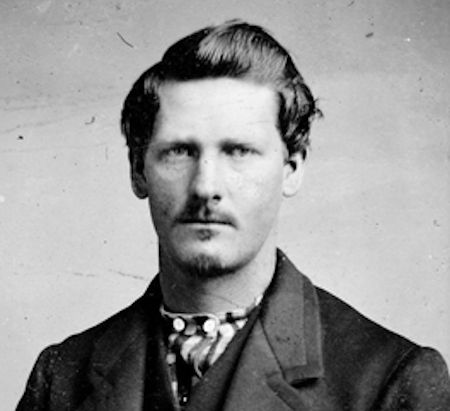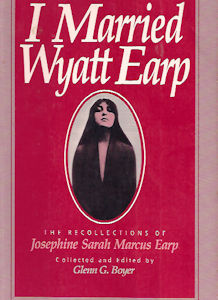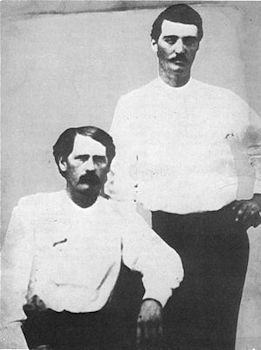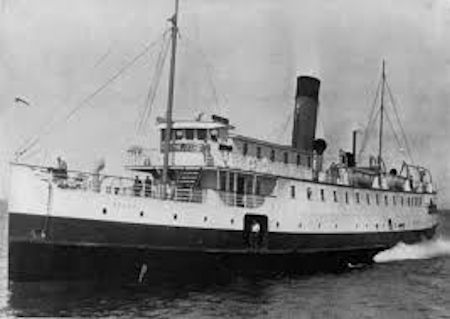 |  |
By Greg Niemann

Legendary frontiersman Wyatt Earp was perhaps best known for the infamous 1881 gunfight at the O.K. Corral in Tombstone. But the part-time lawman actually traveled all over the west – including a little-known trip to Baja California.
Earp even had a run-in with officials when he and another wild west legend, Bat Masterson, went to Ensenada to pick up a prisoner.
Wyatt, the fourth of eight children, grew up in Illinois but in 1864, his family moved to Colton, California. In 1868 most of the Earps returned to Illinois. However, Wyatt and his brother Virgil began their wanderlust by working on the railroad in what is now Wyoming.
Throughout his years Wyatt traveled the west working alternately as a teamster, buffalo hunter, professional gambler, confidence man, owner of several saloons and brothels, silver and gold miner, boxing referee, gunslinger, bounty hunter, shotgun guard, and lawman.
In the wide-open town of Dodge City, Kansas, Wyatt Earp became an assistant marshal working on the Dodge City Peace Commission. Another commission member was deputy marshal William Barclay “Bat” Masterson, who had a considerable background as a lawman and gunfighter.
They often hunted outlaws which took Earp to Texas in 1878 where he met John “Doc” Holliday, a dentist with whom he would also share later adventures.
Earp moved constantly from one boomtown to another. He left Dodge City in 1879 and moved with brothers James, Morgan, and Virgil to Tombstone, Arizona where a silver boom was underway.

Josephine (Josie/Sadie) Marcus
In Tombstone he met his third common-law wife, Josephine (Josie) Sarah Marcus, and they were together for 46 years, until Wyatt died in 1929. (Josie, a former entertainer who was also called “Sadie,” died in 1944).
In the weeks following the historic OK Corral gunfight, Morgan Earp was fatally shot and his brother Virgil was injured by the remaining members of the Clanton gang. Looking for revenge, Wyatt, his brother Warren, and some friends went in search of the assailants and subsequently killed at least two suspects.
Accused of murder, Wyatt Earp fled, moving first to Colorado, then to several boomtowns in the West, and eventually to California.
He and Josie first went to San Francisco. Then they joined a gold rush to Eagle City, Idaho where they owned mining interests and a saloon.
They headed for San Diego in 1887 to take advantage of the real estate boom there. Earp bought four saloons and gambling halls between 1887 and around 1896 in San Diego, offering various games of chance. At the height of the boom, he made up to $1,000 a night in profit. He also owned the Oyster Bar located in the four-story Louis Bank Building. The popularity of the bar was aided by the Golden Poppy brothel upstairs.
Bat looks up his fellow lawman
Not long after moving to San Diego, Earp was contacted by an old friend, Bat Masterson. Masterson and Earp both frequently worked as private investigators for various express companies or as U.S. deputy marshals. Thus, their paths crossed frequently during the 1880s.

Masterson was serving as a deputy U.S. marshal when he came to San Diego, looked up Earp and told him he was going to Ensenada, Mexico in the morning to pick up an army deserter who had been jailed there. Masterson added, “They tell me he’s a pretty tough bird.”
He asked his friend Earp to accompany him to Ensenada and back. “…just to make sure this hombre doesn’t get any ideas.”
In her book, I Married Wyatt Earp, Josie explained, “That made sense to Wyatt. There was no thought in his mind that Bat had any real fears about his ability to take care of himself, I’m sure. But this careful approach, so characteristic of both these men, may account to their survival to a ripe old age despite years in a dangerous business that claimed the lives of many. Neither of them took unnecessary chances.”
Earp agreed, but when he told Josie about the trip, she was disappointed and complained. She had been visiting family and just arrived in San Diego after being separated for several weeks. She wasn’t eager to be apart from him again so soon and said so.
According to Josie, Masterson intervened on her behalf. “Why not, Wyatt?” Bat agreed. “I don’t really expect any trouble. She might as well have an outing too.” “’Suits me,’ my husband agreed. ‘Pack your grip.’”
A steamship to Ensenada
In 1887, The International Company of Mexico operated two steamships from San Diego to Ensenada, and on to San Quintin, where colonists were in the process of settling there. The steamships, which made three runs a week, were generally busy and later during the ensuing Baja gold rush of 1889, were full every trip.
They were able to get tickets, and the next morning the three of them left the long wooden steamship wharf at the foot of Fifth Avenue. “I was a little nervous,” admitted Josie decades later. “The Ensenada of that day was a far cry from the tourist town it later became. I was pleasantly surprised when we found a clean little hotel operated by a ‘Norte Americano.’”
After securing rooms, Bat visited the justice court and made arrangements to pick up his prisoner the next day. With a day to kill before night sailing time, the three enjoyed Ensenada. Josie said that best of all, they found a little posada that served delicious Mexican food which they had become fond of living so close to the border.
Just before the steamer left, Masterson and Earp went to get the prisoner. They were gone a long time, worrying Josie. Returning, Earp said that they had to wait for some big wig to show up. Bat brought his prisoner aboard and shackled him to a steel berth in one of the cabins. Josie and Wyatt retired to a larger cabin, and Josie was nearly asleep when there was a loud knock on the door. It was the ship's purser, informing the Earps that they’d have to vacate and move to another cabin, at once.
Defying the pompous captain
‘¿Por qué?” challenged Wyatt in his rudimentary Spanish, still not opening the door. But then the purser told him that an important Mexican general had come aboard and had been promised the Earp’s cabin, “The hell you say!” he responded. “We paid for this cabin, and we’re staying right here!” Josie, being in a foreign country, admits she was scared out of her wits at the thought of defiance, and whispered to Wyatt to just let them have the cabin.
But Wyatt was firm. After they argued through the locked cabin door for a few minutes, the purser left. He returned a few minutes later with the captain, who was a rather short man with a belligerent attitude. The captain demanded that the Earps move out of their cabin; Wyatt refused and told him to put the general in the other cabin. But the captain kept on shouting until Wyatt felt he had heard enough. Josie described what followed in her memoirs: “Wyatt’s reply was quiet and controlled, but his voice had a quality to it I had never heard before and would only hear a few times after. “’If you don’t go away and leave us alone,' he said in slow, measured words, I’ll throw you overboard.’”
The captain stalked off muttering in defeat. When they touched ground in San Diego the next morning Josie admitted breathing a tremendous sigh of relief.
A tall tale about Tombstone

It wasn’t until later they learned of the sequel of the cabin showdown from Pedro Manriquez, the steamship company’s agent and a friend of Wyatt’s. It appears the captain had stormed in and informed Manriquez that he demanded the arrest of a passenger who had threatened and defied him. When he learned who the passenger was, Manriquez said, “Wyatt Earp? Then you’re lucky to be here. Do you know who Wyatt Earp is?” Pedro Manriquez decided to lay it on thick since he had never liked the pompous little pipsqueak. He told the captain that Wyatt Earp had killed at least half the population of Tombstone, Arizona there in a single afternoon.
“Madre de Dios,” the captain uttered trembling, crossing himself in relief. Later Josie asked Wyatt why he had been so sure the captain would back down and he said “The little such and so wasn’t a big enough man for his job – it stuck out all over him.” After their San Diego years, the couple followed boom towns from Alaska to Tonopah, Nevada, to Vidal, California, before settling in Los Angeles.
Earp has been the subject of numerous films, television shows, biographies, and works of fiction which have increased both his fame and his notoriety. Wyatt Berry Stapp Earp died in Los Angeles on January 13, 1929. Josie always remembered how her husband Wyatt Earp defied a pompous captain and a Mexican general in Ensenada. Along with that great Baja meal, of course.
About Greg
Greg Niemann, a long-time Baja writer, is the author of Baja Fever, Baja Legends, Palm Springs Legends, Las Vegas Legends, and Big Brown: The Untold Story of UPS. Visit www.gregniemann.com.

Only place to get insurance 👍

Michelle is so efficient and thorough.

You cannot beat the convenience and price. We drive vehicles into Mexico all year. Some stay for...